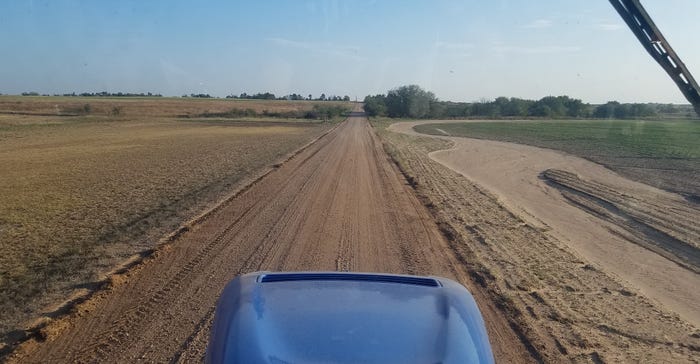
NO-TILL RULES: Barber County farmer Chris Boyd shot this photo as he was moving a wheat drill from one field to another. On the left is one of his no-till fields. On the right, note the stream of silt coming off a conventionally tilled field.
There was a bright side to the heavy rains that brought flooding to many parts of Kansas in early October. The runoff filled pasture ponds and soaked into the profile in the tallgrass prairies of the Flint Hills of eastern Kansas and the mixed grass prairies of the Gypsum Hills in southwest Kansas.
For bone-dry northeastern Kansas, rainfall totals from 4.5 to 7.6 inches brought enough rain to pull the region from the worst categories of drought — extreme and exceptional — to merely "moderate" drought with a couple of patches of "extreme." In central Kansas, which was in extreme drought for most of the summer, the U.S. drought monitor map now shows no drought.
"Our totals are now at 22 inches for the year, which is still way behind, but we don’t need to make up any more of it right now," says Joe Carpenter, a Wabaunsee County rancher who struggled through the summer to maintain water access for cows and calves.
After three days of steady rain from Oct. 6-9, Carpenter says the pasture ponds were finally full, a welcome event going into winter. A full subsoil profile of water is also good news for the grass after months of no rain from June to October.
In the southwest, rancher Ted Alexander says the mixed grass prairie pastures on Alexander ranch are looking "awesome." He says healthy growth grasses and forbes in the riparian areas, along with beaver ponds, kept streams from overflowing, even as rains in some areas topped 11 inches and the Medicine River inundated farm fields of soybeans and sorghum and left water standing on fields where wheat was either newly planted or ready to be planted.
"It really shows you how conservation pays," Alexander says. "We have springs running and streams flowing, and the beaver ponds are full but there really isn’t damage to the grasslands. It’s beautiful actually, kind of the best thing that you could wish for in the grasslands."
Barber County farmer Tom Bedwell says he’s hoping for warm weather and sunshine after the mid-October cold snap. He wants to give the wheat that is up a chance to take advantage of the moisture and get in some strong fall growth. However, he says, the flip side of that will be late growth of the prairie grasses and an increased wildfire danger next spring.
Alexander says he is less concerned about fire because he conducted late summer burns to get rid of invasive plants and eliminate the overgrowth.
For farmer Chris Boyd, the daily downpour of rain brought a real-life lesson in the value of no-till farming that would be hard to match in any conservation demonstration.
"I was moving a wheat drill and went down a road with one of my no-till fields on one side and a neighbor’s conventional till on the other. There wasn’t even water running down the waterway in the no-till field. On the other side of the road, there was a 20-foot-wide stream of silt pouring off the field," he says.
No-till fields growing wheat absorbed the rain, and no-till soybean and milo fields will be dry enough for harvest days ahead of tilled fields.
About the Author(s)
You May Also Like




